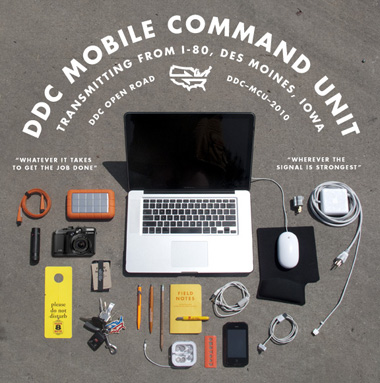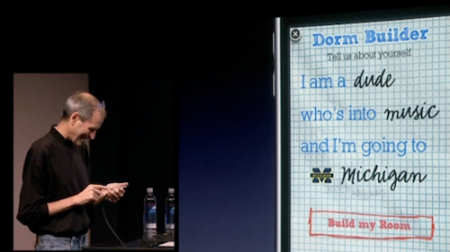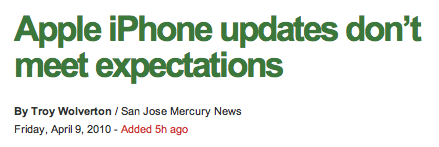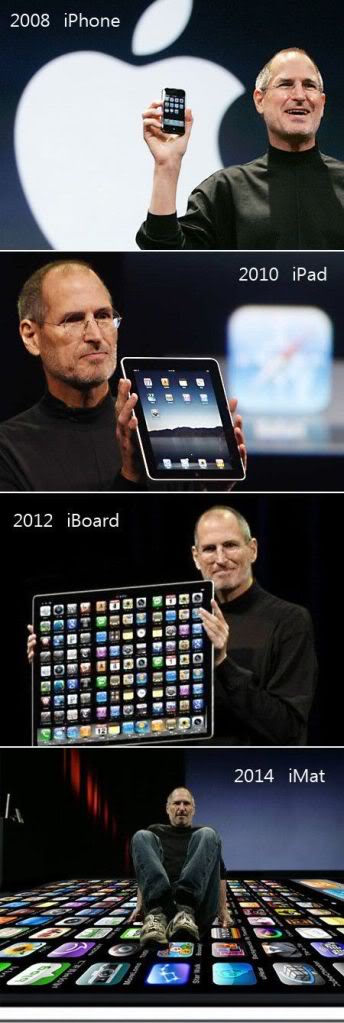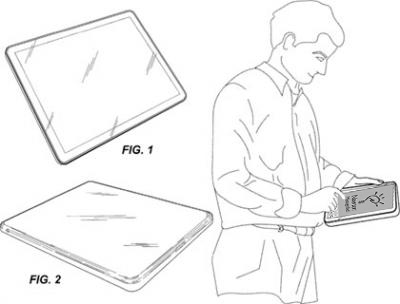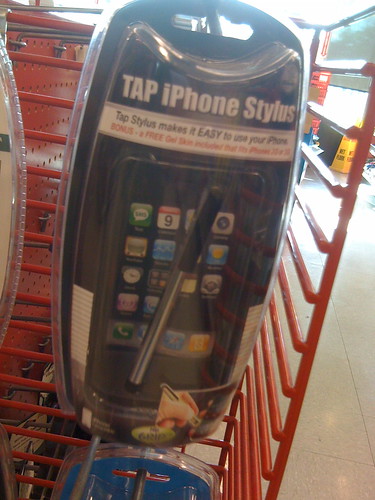Posts categorized “ipod/iphone”.
Steve Jobs: “Go Blue”
April 16th, 2010iPhone expectations
April 9th, 2010Epic
April 1st, 2010Introducing: The hello Show
January 26th, 2010When I bought my first iPod, the first 30 GB video version, podcasts were immediately appealing to me. It was like a talk show I could listen to any time I wanted on any subject I wanted. Over the years, I’ve developed a collection of favorites.
Which is why it’s pretty neat that Newton Poetry reader David Kendal asked me to do a podcast of our own.
So we did one. And it’s out there. We call it The hello Show.
It’s about all the stuff we’re into: Newtons, Macs, the Apple world that we tend to spend an inordinate time thinking about. Probably just like you.
We have a super-simple setup. GarageBand (and, on the other side of the Atlantic, Audacity) plus iChat plus an FTP account – with some of David’s web wizardry – is all we need. So far. We’re definitely learning as we go.
Anyway. Give it a try, if you like. We know there’s plenty out there to listen to, and we’d be honored if you spent an hour or so with us. Shucks, we’d love to have you on The hello Show. If you’d like to be a guest, please contact us and we’ll set something up. It’ll be fun.
Oh. And why “The hello Show?” After a lapse in brainstorming, David sprung the idea of the “hello” text that was featured in the original Macintosh and the iMac advertising. A great idea.
The tablet before the tablet
January 25th, 2010Now that an Apple event later this month is official, the tablet rumor mill will churn with industrial-level speed.
The consensus, from what I’ve read: 7-10″ touchscreen, digestable media (print, video, and otherwise), apps ala carte, and some sort of web connection. All that’s almost certain. And, on the surface, the rumored Apple tablet sounds like an updated Newton MessagePad.
Any similarities are superficial, of course. At 12 years old, even the youngest Newton shows it age. But let’s say we were to take a MessagePad 2000 or 2100, or even an eMate 300, and bring it as close to a modern-day Apple tablet as possible. What would we need?
To start, we’d need applications – and lots of them. We’d also need some connectivity with our Macs or PCs. Some sort of media viewability would have to be there, as would an Internet connection. For people to use it, they need to easily understand how it works. Lastly, we’d need support from Apple.
Fat chance on that last one, and we’d never get a color screen, but the rest of that checklist is doable with the Newton. It wouldn’t be as fast, colorful, or rich as a yet-to-exist Apple tablet. But as a proto-tablet, the Newton is it.
As Wired points out in a recent article about network computer (from Oracle’s Larry Ellison):
We tend to think of technology as a steady march, a progression of increasingly better mousetraps that succeed based on their merits. But in the end, evolution may provide a better model for how technological battles are won. One mutation does not, by itself, define progress. Instead, it creates another potential path for development, sparking additional changes and improvements until one finally breaks through and establishes a new organism.
It’s a great article about how technology often gets ahead of itself in the idea department. In time, the tech catches up with the brainstorm.
I couldn’t help but think of the Newton while reading the piece. In this case, Apple pre-empts itself with its own device.
APPLICATIONS
We’ve seen pieces of the Newton, and of PDAs in general, transform into the modern smartphone: personal information management, notes, on-the-go apps. The Newton was made to be a stripped-down PC to take on the road; not quite as powerful, and much more portable, than a laptop. You could sync it with your computer, or you could run the device completely on its own.
Except for the syncing part, the iPhone does this. In fact, I know friends who only sync their iPhone when they have new iTunes content to upload. Most of the time they’re downloading apps and digesting music from Apple’s mobile apps. After the initial set-up, and if you ignore every software update available, it’s possible to control your iPhone without ever syncing again.
Same with the Newton. It was designed as a mobile computer – a standalone unite – just as some think that Apple’s supposed tablet might be.
Along with the hardware interface, the key is good software. The Newton had its share. In fact, it had apps like the ones Apple brags about in its iPhone commercials – financial apps, games, personal information apps, etc. Some developers are still making apps for the Newton, and work continues of Mac and Windows apps that help manage the device.
The iPhone’s popularity comes partly from its depth and breadth of apps. It’s safe to assume that this app-friendly environment will translate to the tablet.
USABILITY
The Newton’s level of abstraction – souping up a notepad metaphor and controlling it with a pen/stylus – helped make the device understandable. With a tablet, Apple has already done the hard work by standardizing the touchscreen interface. In both cases, Apple takes the prevailing interface innovation of the day and runs with it.
With the Newton, it was pen-based computing. With the iPhone, tablet, and even the mouse/trackpad, Apple is taking touch and building an empire.
MEDIA
In the Newton’s day, consuming iTunes-level media was tough. Hard drives weren’t big enough, Internet speeds weren’t fast enough, and the software didn’t exist to manage all that music and all those movies. We had Quicktime, and some simple CD players, but there’s no way I could have ripped my 8,000-song music library onto the computers of the day.
Given that, there were ways to consume media with the Newton. You can listen to music on one, with a little push and pull, and the Newton’s eBook format is still in use today, with tons of titles available. All before Amazon.com ever launched.
Think of the Newton, and the iPhone today, as the perfect airport device. If you don’t want to lug a bunch of books or a laptop on a trip, the portable Newton is perfect. Read a book, play a few games, scribble some notes to yourself. Whatever. If you’re a small business owner, or hooked up to a large corporate network, you can even get some work done.
This is the tablet ideal: something portable to carry all your consumable stuff.
INTERNET CONNECTION
The Newton was one of the first devices to help the idea of e-mail spread with NewtonMail. Here was a handhald mini computer that you could use to send faxes, make phone calls, and check your e-mail – and even browse the Internet.
A wifi card, a newer-model Newton, and some driver-fu, and you are still in business.
As fun and geeky as it is to connect with a Newton, it still pales to Mobile Safari. The web has grown up a lot, and it makes it almost silly to think about doing anything other than checking out text-only sites.
Now, exceptions exist. If you’re a member of the Newton community, half the fun is seeing how many exceptions you can create. But accessing the web is where the tablet will really shine.
The point is, Apple paved the way in accessing the web from a mobile device with the Newton. With the iPhone and soon, supposedly, the tablet, it’s built a mature system.
FAILURE BEFORE SUCCESS
As the Wired article shows, pioneering projects often come out before the world is ready for them. For Oracle, the network PC lacked the infrastructure to deliver Internet-on-demand computing. But it helped show that the desktop computer wasn’t the last best idea out there.
It is worth noting that, in retrospect, the Newton was an expensive gadget. Without comparing specs and ability, when you look at a $500 unsubsidized iPhone compared to a $1,000 PDA, it’s easy to see where the Newton stretched the average American’s budget too tightly. It could be that, at the time, the technology simply cost more then than comparable technology costs now. Lower costs certainly lead to wider adoption, which explains why the Newton struggled to gain momentum.
But still, with the Newton, the idea of a mobile, self-sustaining device that allows you to consume media, get some work done, and make connections in an intuitive way was set in motion before the world was ready. Apple has shown, with the iPod and iPhone model, that the MessagePad ideals are still viable and ready for action.
Now that everyone is waiting with clenched teeth for the rumored tablet, the Newton ideal seems like it has finally found its place in the world.
Newton keyboard? There’s an app for that
December 1st, 2009Well I’ll be.
The secret is, you have to have a jailbroken iPhone and a few connectors (details at the namedfork.net source page), but man – look at that thing in action.
Lots of luck to anyone who tries it.
[Via Thomas Brand.]
CNet UK pits Newton vs. iPhone
November 27th, 2009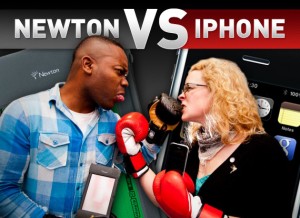
We’ve seen this kind of thing before from the chaps at CNet’s UK edition: a battle of the handhelds, this time featuring the Newton MessagePad and the iPhone.
The duel features arguments over design, screen quality, applications, reliability, connectivity, and “special powers.”
Rory, the dude who sided with Samsung in the last smackdown, chooses to battle with the Newton this time around, and sticks it to the iPhone with the Newton’s app selection:
The Newton, a device older than Jamie Lee Curtis, has both copy and paste, a global search function and the ability to multitask. When it first emerged, the iPhone had none of these things and not even the iPhone 3GS — the daddy of all iPhones — can properly handle more than one application at a time.
I won’t ruin the ending for you, but it’ll probably come as a (contrived) surprise.
I did my own head-to-head battle quite a while ago, but what I missed out on was the fun boxing graphics. Now I know.
Simple steps to audio perfection
October 26th, 2009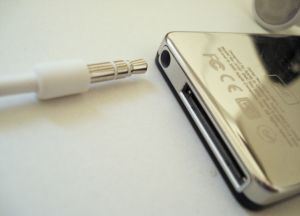
Sometimes the best finds in life come from sheer accident.
That’s definitely the case with the plug-in USB charger I found in my local Meijer auto section while browsing through the aisles on a whim.
First, let me say I bought a new car – a 2004 Volkswagen Jetta 2.0L. I’ve always wanted one, and I got a real beauty at a great deal.
When I travel, though, I always make sure I have a way to listen to my music and charge my iPod or iPhone. The Jetta does not have an auxilery jack in the Monsoon stereo. What it does have, however, is a universal power outlet in the middle console.
Before, I’ve used products like Griffin’s RoadTrip and similar devices that transmit an iPod’s music through an FM signal to the stereo while charging the device.
I purchased a new RoadTrip last winter to work with my iPhone 3G. Over the summer, however, it was stolen out of my car. The killer is, these devices are not cheap – so it’s not like I can easily replace an FM transmitter. On average, they can run from $50 to $100.
But with my new car, I wanted something that would let me listen to my iPod music while driving. I hoped to find something on sale, or at a reasonable price. Unfortunately, I saw the same products at the same prices, and left the iPod gadget aisle.
Then I stopped in to the automotive section at Meijer and looked at the offerings there. What I saw surprised me: the car stereo section featured many of the same products as the iPod section, but from different manufacturers. And at much cheaper prices.
While browsing, a little gadget caught my eye. It was a simple power jack with two USB ports in the back. All it did was power a USB-controlled device, like a phone, digital camera, or MP3 player. That’s it.
And it was $5.
Where the heck has this little handy gadget been hiding? It was just what I needed: a convenient device that did one thing (charge my iPhone/iPod) through a USB connection. I could bring my Apple-provided USB cable, the same one I sync my iPhone with, along on car trips when I need the extra power.
For music playback, I went old school. My Jetta comes with a cassette tape player (that awful, awful technology), and I still had my cassette-to-CD player adapter from high school. Back then, I would bring my portable CD player and connect it through the adapter to my stereo. The adapter works with a simple 3.5 mm headphone connection, meaning I could plug it into the headphone jack in my iPod or iPhone and be in business.
So for $5 and an old relic, I have everything I need to listen to my music and charge my iPods.
I could even charge my Shuffle if I brought along its unique plug-in dock. Sure, this means a few cables (the USB cable, the cassette adapter cable) running around my middle console, but I sure can’t beat the price.
An added benefit is the audio fidelity. Before, with my FM transmitters, I’d fuss with the stereo and transmitter settings trying to find the right station without a bunch of static. Now, with something as simple as a cassette adapter, I get great sound. It’s not perfect, but it’s good enough.
The lesson I learned is sometimes simpler is better. I was lucky enough to have everything – a cassette player, a conveniently-placed power outlet – at my disposal. But I was also lucky enough to go shopping in my local retailer’s automotive section, too, which is something I didn’t know before.
Often, when you buy a product, you’re just buying the name. Some people claim that about Apple, of course, but in the case of iPod accessories, it really is true.
iPhone stylus in the wild
September 11th, 2009Saw this little beauty in a local auto parts store (!), right next to iPhone skins and car chargers.
I like how it says “makes it EASY to use your iPhone.” Like using a finger is hard? Maybe if you have big fingers.
The most useful part of the package might be the included gel skin, but I can’t say that in all fairness. I haven’t tried an iPhone stylus.
Shucks, I even press some of the Newton’s on-screen buttons with my finger, just to get things moving along quickly.
